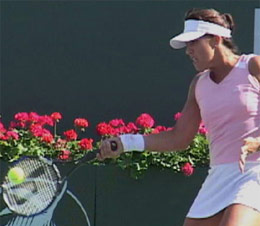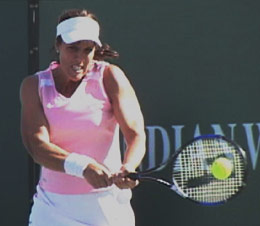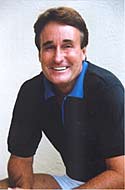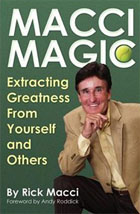Capriati's
Groundstrokes
Rick Macci
Jennifer Capriati has some of the best groundstrokes of anyone ever to play the game of tennis. In my opinion, they are perfectly suited for the women's game. And I'll tell you why.
Developing Capriati
I like to look down the road. In 1987, when Jennifer came to me at age 10, I could see where women's tennis was going. It was going away from a game based on consistency to a game based on weapons. I had seen this kid named Monica Seles play. I saw that she could be great. Then there was Steffi Graf. And we talked early on about developing Jennifer's game so that some day she could beat Steffi. I mean we actually talked about that at age 10. I wasn't worrying about Jennifer winning the 12 and under tournaments in Florida. Her dad Stefano didn't want those type of trophies and neither did I. There was a bigger picture, because the kid had talent.
The problem when Jennifer started with me was that she was playing five or six feet behind the baseline, like Chris Evert. At that time she seemed almost like a Chrissy clone. She had great balance and preparation. But she had a defensive mindset. She was steady and kept the ball in play.
I knew that wasn't going to cut it. I don't think she could've become world class playing that way. I saw that for her consistency wasn't going to be enough. It's not consistency, everybody's consistent. It's the quality of your consistency It's the quality of the shots that you're consistent with. I set out to transform her from a counterpuncher into a dictator.
The first step was to put her right up on the base line. I wanted her to take the ball early. I wanted to build weapons and develop a game that could hurt people. It was an easy sell because of her personality. Jennifer Capriati was feisty and she had a little vinegar inside of her and she liked to pump the ball.
When Jennifer was 12 years old, she won the 18 and under national hardcourts. She's still the youngest one ever to do that . She was younger than both Tracy Austin and Andrea Yeager. That would be almost impossible now. She beat players who are still on the pro tour today. Then she followed that up by winning the national clay courts.
She was 5'4" and 110 pounds. She didn't do it on her size, she did it on playing the ball near the baseline, the way she plays today. She played the ball. She didn't let the ball play her. Her size was a not a liability. Her court positioning and technique made up for her lack of size.
Women versus Men
Let's talk for a minute about men's tennis versus women's tennis. They call them both tennis, but to me they are two different sports. And that's not being detrimental to the women or the men. It's just the way it is.
Woman's tennis is more of a ball striking sport. It's a cleaner flatter game. I firmly believe that 95% of women's tennis is all about ground strokes. The serve is going to come into play, but in most cases it's not really the difference. I mean you can have major short comings. You can haved no volley, a crummy serve, and average mobility, but if you can tear someone's head off with your groundstrokes, there there's a place for you in the top twenty.
With the men it's more of a physical game. It's more of a movement game. The men are covering a lot more real estate. So as a result to succeed in men's tennis have to have more versatility. You've got to learn how to spin the ball. You've got to have more of a package. You got to be able to volley, you got to be able chip. You've got to have creativity. You have got to develop a serve.
Grips
But with the women, it's all about developing weapons off the ground. That's why the right grips are so important. Success in women's tennis starts with the grips. You'll you never see greatness on the women's tour with the western grip. Let me say this straight out: it's a huge mistake to teach junior girls a western grip. Don't do it. What I did with Jennifer was similar to the way Robert Lansdorp developed Lindsay Davenport. I believe the eastern grip foundation is what made it possible for them to develop forehands that would be real weapons in pro tennis.
But that goes against everything you actually see in the juniors. You can go watch the national tournaments in 12's and 14's, and the girls that are winning are the ones in the prevent defense. They are underneath the handle hitting topspin moonballs. They're flipping, they're dipping and they never miss the ball. And everyone says, "That kid is great ! She never misses!" And what it all means is that they're never going to be that good.
Because the ones that are missing are the ones that are going to keep improving.
If any parent wanted to see how their daughter should hit the tennis ball or wanted their child to copy one player, it would be Jennifer Capriati or Lindsay Davenport. Capriati has powerful grips, and she had them from the beginning. That was the foundation for the big picture. And I believed that from the beginning. And I still do.
 |
 |
For Jennifer and other junior girls I coach, powerful grips is where it starts. |
|
Jennifer has a modern Eastern forehand grip similar to Pete Sampras. Some people might call this a mild semi-western. The terminology doesn't really matter. The point is that most of her hand is behind the racket head. On her backhand she has a continental grip with the right hand. Her grip with her left hand is eastern, similar to her forehand. This is critical. I see far too many young players who have little or no backhand grip shift with the right hand, and are semi-western or worse with the left.
Jennifer's grips are conducive to hitting the ball cleaner and flatter on both sides. Your natural stroke should be to go hard and deep, clean without any effort, and it all starts from the grips. So Jennifer had the grips at an early age to develop weapons. When people watch Jennifer they say it looks like the ball is on a string.
This is a major problem that I have today--the grips of the young players that come here to work with me. We spend a lot of time changing grips. These young players can hit the ball over the net--sure--but they are heading towards mediocrity. They don't have powerful grips. They can't put their hands in position to drive the ball and penetrate the court.
It's probably the single most damaging thing in tennis teaching around the world, especially for the girils. Coaches wants younger players to get the ball over the net. So "Spin is in." They aren't interested at a young age in building a weapon. Either they don't have the vision, or maybe they don't have the knowledge. Which is unfortunate because the cards you're dealt at 8, 9, or 10--you can be stuck with those cards forever. It's hard to do an extreme makeover when a player has already hit the ball a certain way a million times.
I've seen grips cost pro player millions of dollars. Millions of dollars! Just because of the way they held the racquet.
Amelie Mauresmo is one of the best players in women's tennis, but no one would say she has one of the best forehands. In fact, it's probably not even one of the best fifty forehands. That's her liability. If she had Jennifer Capriati's forehand,she might be winning majors.
Another example: Arantxa Sanchez. She had great legs, a great backhand. She was an unreal fighter. If she had had a forehand she might have gone through her career undefeated. There are many other players that have been ranked thirty, forty, or fifty in the world. You look at their forehands and they can't break an egg. All they can do is flip the ball. And when they play at the next level, the top players just destroy them.
Hitting Through the Ball
Her grips give Jennifer the ability to hit through the ball. If you look at her hands you'll see what I mean. Jennifer stays with the contact. I tell the kids it's like pushing water in the bathtub with you hand.
The eastern grip is conducive to staying with the ball longer instead of flipping over it. Don't flip it because you have flip or you can only flip. Don't let that be your normal stroke. Flip when you want to flip. There is a time and a pace for spin. If you look at most players a few frames after contact they've already broken the hand. If you look at Jennifer you'll see the hand doesn't break.
If you have the right grip you can produce power. If you came to my academy and looked at some of the players I train, you'd be amazed. Tthese little kids that are four foot eight and weigh sixty-two pounds. How can they get so much power? Is it steroids? Is Rick Macci giving drugs to young children? No, it's timing. It's the ability to take the ball early and hit through the shot.
Preparation
Let's take a look at Jennfer's strokes, starting with the preparation. If you look at the animation, the ball isn't even in the picture, and Capriati has the shoulders turned. The racquet's back, she's balanced, she's loaded up on her back foot. I've said it many times all around the world Jennifer has some of the best preparation ever in the history of women's tennis. It's similar on both sides, forehand and backhand.
For that we can credit Jimmy Evert, Chris's dad, who gave her first lessons. He instilled that in her. One thing anybody can learn from Capriati--and it's a main stay of her game--is early preparation. I think everybody agrees she's not the quickest or the fastest player ever to play tennis, even though she's a good athlete. But if her preparation had been shaky or fragmented she never would have achieved everything she has.
She has a great shoulder turn. It starts with a unit turn. She uses that left arm to make sure she turns. She uses the left hand as what I call a guiding mechanism.
Notice also how her he left foot is behind the ball. One of the biggest mistakes people make is they set up too far away from the ball and then they have to swing across the body. With her left foot behind the ball it is very easy for her to rotate so her weight into the ball when she goes cross court.
Even on the tour today there are players that have very shaky preparation, and they can only play on slower surfaces. They are limited--permanently. This is caused mainly by the timing they develop as juniors. Often they grew up on clay with high bouncing balls. They let the ball hit the court and then they start to prepare.
Unfortunately too many American junior players have the same problem, even if they play on hardcourts. I don't think preparation is a priority for our players when they are young. The ball gets there fairly slow and high. So, unfortunately you can get away without really preparing early. Until you go up a few levels--and then suddenly it's too late.
Since it's not critical to winning matches early in the juniors, a lot of coaches let the kids get away with it, because they are training them for the moment. They're not training them for the future. They don't have a vision. They don't see a bigger picture.
Compare that with Jennifer. Every back swing, every shoulder turn on every stroke isexactly the same. I mean, it's like I'm looking at the same shot over and over when I look at the video. It's machine like. And you don't see that a lot with other players.
The preparation sets the racket on edge, and from there she is uncoiling.
She stays with the ball and the contact is way out in front. It looks like to me she's hitting through like seven or eight balls before she goes up.
This is what separates her from a lot of the players. Jennifer was always concerned about preparation, hitting through the ball and following through. She can hit open stance depending on the situation, but she'll also step into balls. Either way she is perfectly balanced.
See how her arm extends. There is a common misconception that you should wrap the racket around your body as quickly as possible after the hit. That's not what Jennifer does. Watch how much she extends. When she changes the finish, it's for a purpose. To hit a reverse forehand, or to hit a short angle or to hit a top spin lob.
Pivot and Point
Here's a drill that I like to use. It's called the Pivot and Point. I did with Jennifer and I still use it today. The Pivot and Point teaches kids how to hit through the ball like Jennifer. I have them put the racquet on the edge and I have them "pivot and point." I say, "Don't move the racquet." All they are going to do is pivot their body and they are going to point their racquet at their opponent.
They pivot their bodies and the balls are right in the center of the racquet. And the kid's find this: "I'm doing less and I'm hitting better. And all the balls are going deep."
Grab It
Besides learning to play up on the baseline and take the ball early, we made one more important change in Jennifer's forehand. I had to teach her how to grab the ball. She tended to hit across the ball, similar to what Chris Evert did, and hit with side spin.
When she hit down the line this was actually a good shot because it tailed away from the opponent, but she could never grab the ball and hook it. She couldn't whip short angles or hit top spin lobs.
She didn't feel how the strings could work with the ball. The way she was taught the strings came across the ball. She was hitting it so flat I could see the seams when the ball was going back the other direction.
It was amazing, but I had to break it down almost to the beginner level. The first progression we just dropped the ball. And I just had her whip up the back of the ball. We hit a lot of top spin lobs.
I'd say: "Jennifer I don't want to see the seams. I want to see the ball spin." She actually had to get an understanding of what the ball should look like and how it was rotating. There's spin on the ball, but it's a tight spin.
And Stefano fought me at first and told me I was going to ruin the stroke, but I persevered, because I knew I was right. Slowly she started grabbing the ball. And gradually they both came around and understood what the value was. It took some time but when Jennifer was finally sold on it, and made it hers, then her forehand was a done deal. It was game set match Capriati, because she was coming to the court not only with a fighting spirit, but with AK-47s blazing.
Read more Rick Macci articles analyzing strokes of his famous students: Andy Roddick: Serve Andy Roddick: Forehand Venus Williams: Two-Handed Backhand |





